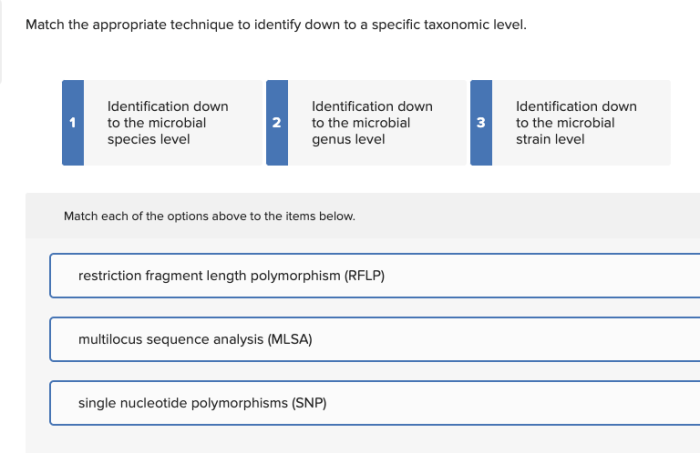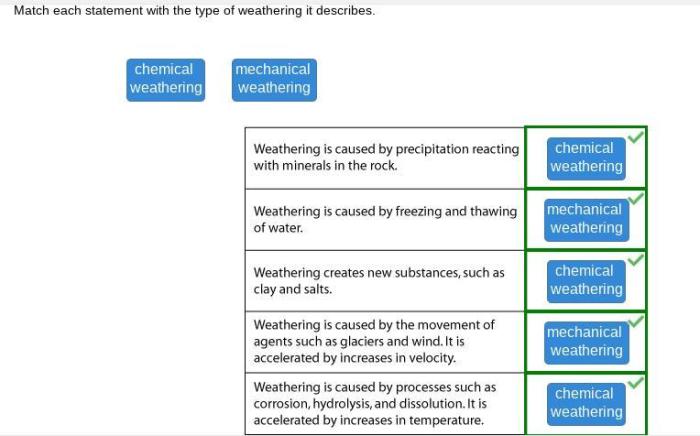Match each statement with the microbial identification technique it describes – Embark on a journey through the realm of microbial identification techniques, where diverse approaches converge to unravel the mysteries of the microbial world. This comprehensive guide delves into the principles, applications, and limitations of various techniques, empowering readers with a deep understanding of how scientists identify and characterize microorganisms.
From the time-honored Gram staining to the cutting-edge molecular techniques, each method offers unique insights into the microbial landscape. This guide provides a thorough exploration of these techniques, enabling readers to navigate the complexities of microbial identification with confidence.
Microbial Identification Techniques: Match Each Statement With The Microbial Identification Technique It Describes

Microbial identification is a critical aspect of microbiology and clinical practice. It enables the accurate diagnosis and treatment of infectious diseases, as well as the study of microbial ecology and evolution. Numerous techniques have been developed to identify microorganisms, each with its own principles, advantages, and limitations.
Gram Staining
Gram staining is a differential staining technique that classifies bacteria into two groups: Gram-positive and Gram-negative. It is based on the ability of bacteria to retain a crystal violet dye after treatment with an iodine solution and alcohol. Gram-positive bacteria retain the dye and appear purple, while Gram-negative bacteria lose the dye and appear pink or red.
Examples of Gram-positive bacteria include Staphylococcus aureusand Streptococcus pneumoniae, while examples of Gram-negative bacteria include Escherichia coliand Pseudomonas aeruginosa.
Gram staining is a simple and inexpensive technique, but it has some limitations. It cannot differentiate between all bacterial species, and it is not useful for identifying bacteria that are not easily stained.
Acid-Fast Staining
Acid-fast staining is a differential staining technique that identifies bacteria that are resistant to acid and alcohol. These bacteria are known as acid-fast bacteria and include Mycobacterium tuberculosisand Mycobacterium leprae.
The procedure for acid-fast staining involves treating the bacteria with a carbol fuchsin dye, which is then heated to drive the dye into the bacteria. The bacteria are then treated with an acid-alcohol solution, which removes the dye from non-acid-fast bacteria.
The acid-fast bacteria retain the dye and appear red or pink.
Acid-fast staining is a useful technique for identifying acid-fast bacteria, which are often associated with serious infections.
Culture-Based Identification, Match each statement with the microbial identification technique it describes
Culture-based identification is a technique that involves growing bacteria on a solid or liquid medium. The bacteria are then identified based on their colony morphology, growth characteristics, and biochemical properties.
The steps involved in culture-based identification include:
- Collecting a sample from the patient
- Inoculating the sample onto a culture medium
- Incubating the culture at an appropriate temperature
- Observing the growth of the bacteria
- Performing biochemical tests to identify the bacteria
Culture-based identification is a reliable and accurate method for identifying bacteria. However, it can be time-consuming and requires specialized equipment and expertise.
Biochemical Tests
Biochemical tests are used to identify bacteria based on their metabolic activities. These tests are typically performed on bacteria that have been grown in culture.
There are a wide variety of biochemical tests available, each of which targets a specific metabolic pathway. Some common biochemical tests include:
| Test | Target Microorganism |
|---|---|
| Catalase test | Bacteria that produce catalase, such as Staphylococcus aureus |
| Oxidase test | Bacteria that produce oxidase, such as Pseudomonas aeruginosa |
| Urease test | Bacteria that produce urease, such as Proteus mirabilis |
Biochemical tests are a relatively simple and inexpensive way to identify bacteria. However, they can be time-consuming and may not be able to differentiate between all bacterial species.
Molecular Techniques
Molecular techniques are used to identify bacteria based on their genetic material. These techniques are typically performed on DNA or RNA extracted from bacteria.
Some common molecular techniques include:
- Polymerase chain reaction (PCR)
- DNA sequencing
- Microarrays
Molecular techniques are highly specific and sensitive, and they can be used to identify bacteria that are difficult or impossible to identify using other methods.
Immunological Techniques
Immunological techniques are used to identify bacteria based on their antigens. These techniques are typically performed on antibodies that have been raised against specific bacteria.
Some common immunological techniques include:
- Serological testing
- Immunofluorescence
- Western blotting
Immunological techniques are highly specific and sensitive, and they can be used to identify bacteria that are difficult or impossible to identify using other methods.
FAQ Summary
What is the most commonly used microbial identification technique?
Gram staining is the most widely used microbial identification technique due to its simplicity, cost-effectiveness, and ability to provide rapid results.
How do molecular techniques differ from traditional identification methods?
Molecular techniques, such as PCR and DNA sequencing, analyze the genetic material of microorganisms, providing highly specific and sensitive identification, even for closely related species.
What are the limitations of immunological techniques in microbial identification?
Immunological techniques can be limited by cross-reactivity, which occurs when antibodies bind to multiple different microorganisms, potentially leading to false-positive results.


